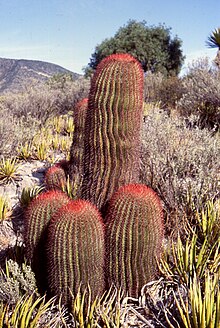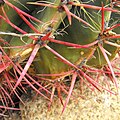Ferocactus pilosus
| Ferocactus pilosus | |
|---|---|

| |
| Scientific classification | |
| Kingdom: | Plantae |
| Clade: | Tracheophytes |
| Clade: | Angiosperms |
| Clade: | Eudicots |
| Order: | Caryophyllales |
| Family: | Cactaceae |
| Subfamily: | Cactoideae |
| Genus: | Ferocactus |
| Species: | F. pilosus
|
| Binomial name | |
| Ferocactus pilosus (Galeotti ex Salm-Dyck) Werdermann
| |
| Synonyms | |
| |
Ferocactus pilosus, also known as Mexican lime cactus (Biznaga De Lima) or Mexican fire barrel, is a species of cactus in North America.
Description
[edit]Ferocactus pilosus grows singly or forms large clumps, reaching heights up to 3 meters with diameters of 50 cm (20 in). It has 13 to 20 non-humped ribs, initially sharp-edged in young plants and later becoming rounded. The areoles are close together, giving the appearance of almost merging into one another. The bright red or yellow, spreading spines are pubescent and slightly curved, making it difficult to distinguish between central and radial spines. The mostly red, six to 12 central spines are strong, reaching up to 5 cm (2.0 in) in length, while the radial spines are typically reduced to numerous, whitish bristles.
The yellow to red flowers appear in circles around the shoot tip, measuring up to 4 cm (1.6 in) in length and 2.5 cm (0.98 in) in diameter. The yellow fruits are egg-shaped, about 3 to 4 cm (1.2 to 1.6 in) long.[2]
-
Ferocactus pilosus (detail of growing point)
-
Flower buds
-
Spines
-
Plant growing in Oasis Park Fuerteventura
Distribution
[edit]The cactus is endemic to the Chihuahuan Desert, located in northeastern Mexico.[3]
It is native to the Méxican states of Coahuila, Durango, Nuevo Leon, San Luis Potosí, and Tamaulipas, found growing on rocky limestone slopes.[4][5]
-
Habitat near Ranch San Rafael, Nuevo Leon
-
Plant growing in Luis Potosi
-
Plants in habitat in Concepcion del Oro, Zacatecas
Taxonomy
[edit]First described as Echinocactus pilosus in 1850 by Henri Guillaume Galeotti in Joseph zu Salm-Reifferscheidt-Dyck's Cacteae in horto Dyckensi cultae anno 1849, the specific epithet pilosus, meaning 'hairy' in Latin, refers to the species' thorns.[6] Erich Werdermann transferred the species to the genus Ferocactus in 1933.
References
[edit]- ^ SG), Succulent Plants; SG), Succulent Plants (2009-11-16). "The IUCN Red List of Threatened Species". IUCN Red List of Threatened Species. Retrieved 2024-02-10.
- ^ Anderson, Edward F.; Eggli, Urs (2005). Das grosse Kakteen-Lexikon (in German). Ulmer. p. 296. ISBN 3-8001-4573-1.
- ^ Anderson, Edward F. (2001), The Cactus Family, Pentland, Oregon: Timber Press, ISBN 978-0-88192-498-5, p. 334
- ^ CactiGuide: Ferocactus pilosus
- ^ Art, Cactus (2013-08-04). "Ferocactus pilosus". LLIFLE. Retrieved 2024-02-10.
- ^ Salm-Reifferscheidt, Joseph; Georgi, Carl (1850). Cacteae in horto Dyckensi cultae anno 1849, secundum tribus et genera digestae : additis adnotationibus botanicis characteribusque specierum in enumeratione diagnostica cactearum Doct. Pfeifferi non descriptarum /. Bonnae: Apud Henry & Cohen, typis C. Georgii. doi:10.5962/bhl.title.120333.
External links
[edit] Media related to Ferocactus pilosus at Wikimedia Commons
Media related to Ferocactus pilosus at Wikimedia Commons Data related to Ferocactus pilosus at Wikispecies
Data related to Ferocactus pilosus at Wikispecies- Cacti of Mexico
- Flora of the Chihuahuan Desert








